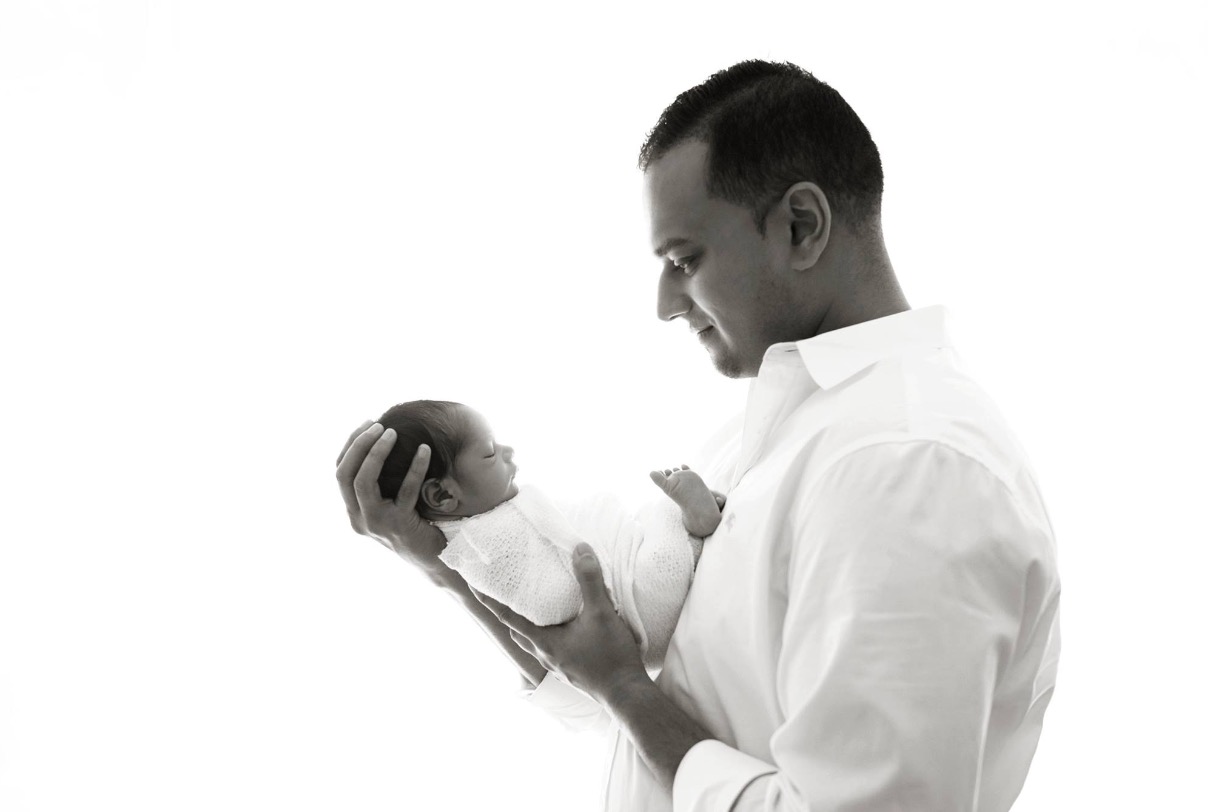When I was a new mom, there were plenty of books about how to physically care for a newborn: how to swaddle, how to change a diaper, and how to treat skin conditions. But there was next to nothing on how to care for a newborn’s psychological well-being. What’s important for infant mental health? Erik Erikson, the famed psychoanalyst of the sixties, recommended eye contact for the foundation of newborn trust—so I spent a lot of time looking at my newborn baby girl.
That’s a start.
photo credit Sugarplum Photography
Since then, developmental scientists have learned a lot about what gets babies off to a good psychological beginning. And it’s deceptively simple: It’s about breath and heart; rhythm and timing; paying attention.
States
For nine months of pregnancy, the mother’s body provides everything a baby’s body needs: nutrition, oxygen, temperature control, and waste management. When the two bodies separate, the baby’s body has to learn to regulate all of these processes itself…amid myriad new sensations like sights, sounds, tastes, temperature fluctuations, restrictions, movements, and more. The simple coordination of the first breath with the heartbeat is itself a wonder of biological engineering.
As the baby’s body takes over its own bio-rhythms, it rapidly cycles through different states. In the space of one-and-a-half to two hours, the baby turns a tight schedule that keeps parents on their toes and is completely at odds with an adult sense of time. But how parents respond to these changing states forms a foundation for the baby’s later psychological and social development.
Generally speaking, there are six states, with transitions in between:
photo credit Nancy Kohli Haté
Deep sleep: The baby sleeps quietly without moving, and breathing is regular
Light sleep: The baby might move, may have irregular breathing and even startle at noises, or may experience eye movements in the dreamy sleep of REM sleep (rapid eye movement). Babies can cycle between deep and light sleep, even within an hour. Sometimes, in the first few months of life, babies wake between the deep and light sleep cycles and have difficulty returning to sleep. (Newborns sleep about 16 hours a day, and about half of that is in REM sleep.
Drowsiness: In the transition between waking and sleeping (e.g., waking up, or conversely, going to sleep), the baby’s eyes may open and close, or even roll back. The baby might stretch, yawn, or doze.
Quiet alert: The baby’s face is bright, eyes are open wide, and the body remains quiet. This is time when the baby takes in her environment on her own terms. She might be looking, or staring, or simply quietly focusing on what she sees, hears, or senses. This is a good time to give babies their space, to let them get used to feeling comfortable settling alone.
Active alert: The eyes are open and scanning and alert, and both the facial expressions and body are medium-active. Babies are especially open to social interaction in this state, so this is a good time to gently engage with the baby, talking quietly, singing, touching.
Crying/fussy: A baby cries, screams perhaps, and the whole body and soul can become quite stressed and disorganized. Babies are born nearly helpless, so crying is the best signaling system to recruit outside help to regulate a need. With experience, parents soon anticipate the various needs—to eat, to be comforted, to be changed, to warm up or cool down, for more or less stimulation, to be eased into sleep.
photo credit Rohan Haté
The underlying biology: oscillators and pacemakers.
Scientists have so far pointed to two biological mechanisms that underlie infant states and that have implications for later psychological development:
The oscillator controls the sleep-wake cycle. It develops in a fetus at about 30 weeks in utero, in a region called the suprachiasmatic nucleus, which is in the hypothalamus just above the brainstem. Even in utero, a fetus begins a tiny sleep-wake cycle: researchers and mothers alike notice that in the last trimester, the fetus is more active at some times and in quiet sleep at other times. The cycle is short (called an ultradian rhythm), but after birth it begins the long march toward a circadian rhythm—one that harmonizes with the light and dark cycles of a 24-hour period. Before birth, the sleep-wake oscillator is sensitive to conditions in the fetal environment, like the maternal hormone melatonin as well as the intrauterine environment such as mother’s diet and exposure to light and dark. After birth, postnatal practices like the skin-to-skin contact called kangaroo care are related to longer periods of alertness and more organized sleep-wake cycles.
The cardiac pacemaker regulates the pace of the heartbeat and coordinates the heartbeat with the breath to alternately activate (in-breath) and calm (out-breath) the heartbeat. This is part of the autonomic nervous system (ANS) that originates in the brain stem and connects many organs in the body—the heart, lungs, eyes, glands and digestive tract. The ANS is roughly divided into the sympathetic nervous system (SNS), which goes on metabolic alert when the baby is in need or distress, and the parasympathetic nervous system (PNS), which calms and soothes and restores the system once again.
Developmental scientists have become especially interested in the calming system arising from the vagal tone. The vagus nerve is the 10th cranial nerve, a complex web of connections from the brainstem and reaching throughout the body that control and put the brakes on stress, shifting bodily resources away from fight or flight and back to “restore and grow.” Like the oscillator, vagal tone is also perceptible in the third trimester, around 33-35 weeks gestational age. After birth, it, too, is enhanced through the skin-to-skin contact of kangaroo care and even infant massage. Not surprisingly, sensitive care encourages a strong vagal tone.
Synchrony: the dance between caregiver and newborn.
A new parent’s first challenge is to figure out how to react to a baby’s changing states. Granted, there is physical care involved—changing diapers, dressing, bathing, feeding, and more. But it is the process of joining a baby’s rhythm—not just physically, but psychologically, in harmony—that is most important for creating a strong psychological foundation. Psychologists have given this process many names: responsive care, attunement, and co-regulation.
Ruth Feldman, a psychologist at Bar-Ilan University in Israel and at the Yale School of Medicine, calls this coordinated interaction between caregiver and infant, “synchrony.” At first, she says, the relationship is biological: Pregnancy produces surges in the bonding hormone oxytocin in the mother, which primes her to attend to her baby (nonbiological parents generate oxytocin through interactions). In research studies, mothers with more oxytocin reported having more pleasurable feelings with their babies than mothers with lower levels of oxytocin. They were also observed to react in more sensitive ways, more often, to their babies’ behaviors.
In turn, as the baby is touched, or has skin-to-skin contact, or is breastfed, her nervous system is calmed, the biological clock organizes, and the vagal tone develops. Responsive, loving, warm care in the first weeks and months of life can even turn on or off the genes that regulate a baby’s stress.
Caring for a newborn changes parents' brains. As parents gaze at their newborn; talk gently; use soft, higher-pitched voices; and are positive, warm, and encouraging, their brain’s gray matter, or cell bodies, actually grow in the emotion and thought regions that support parenting behaviors.
Timing is important. In one of Feldman’s studies, when mothers appropriately chose the babies’ alert state to talk and touch their babies, the babies remained alert for longer periods of time.
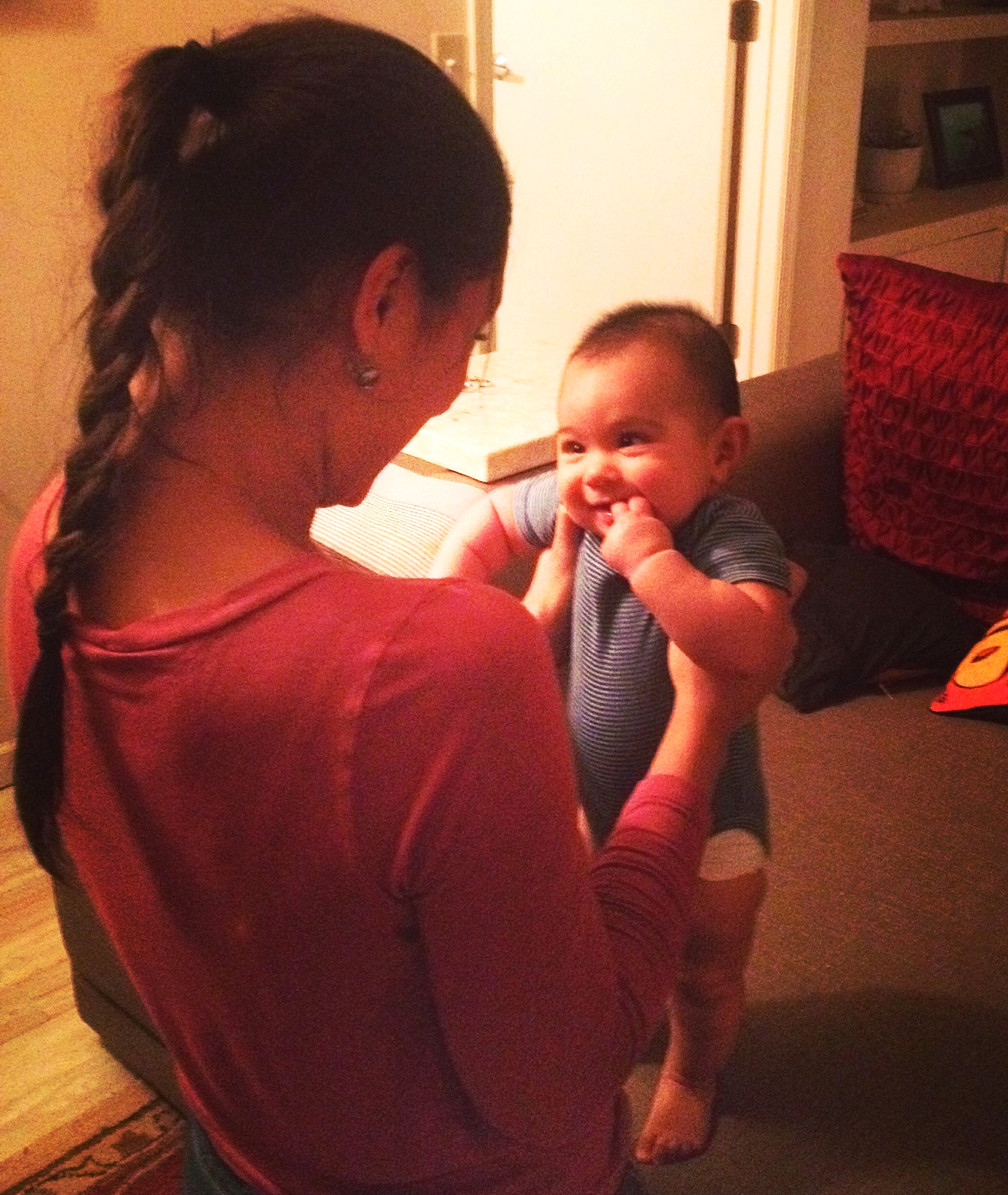
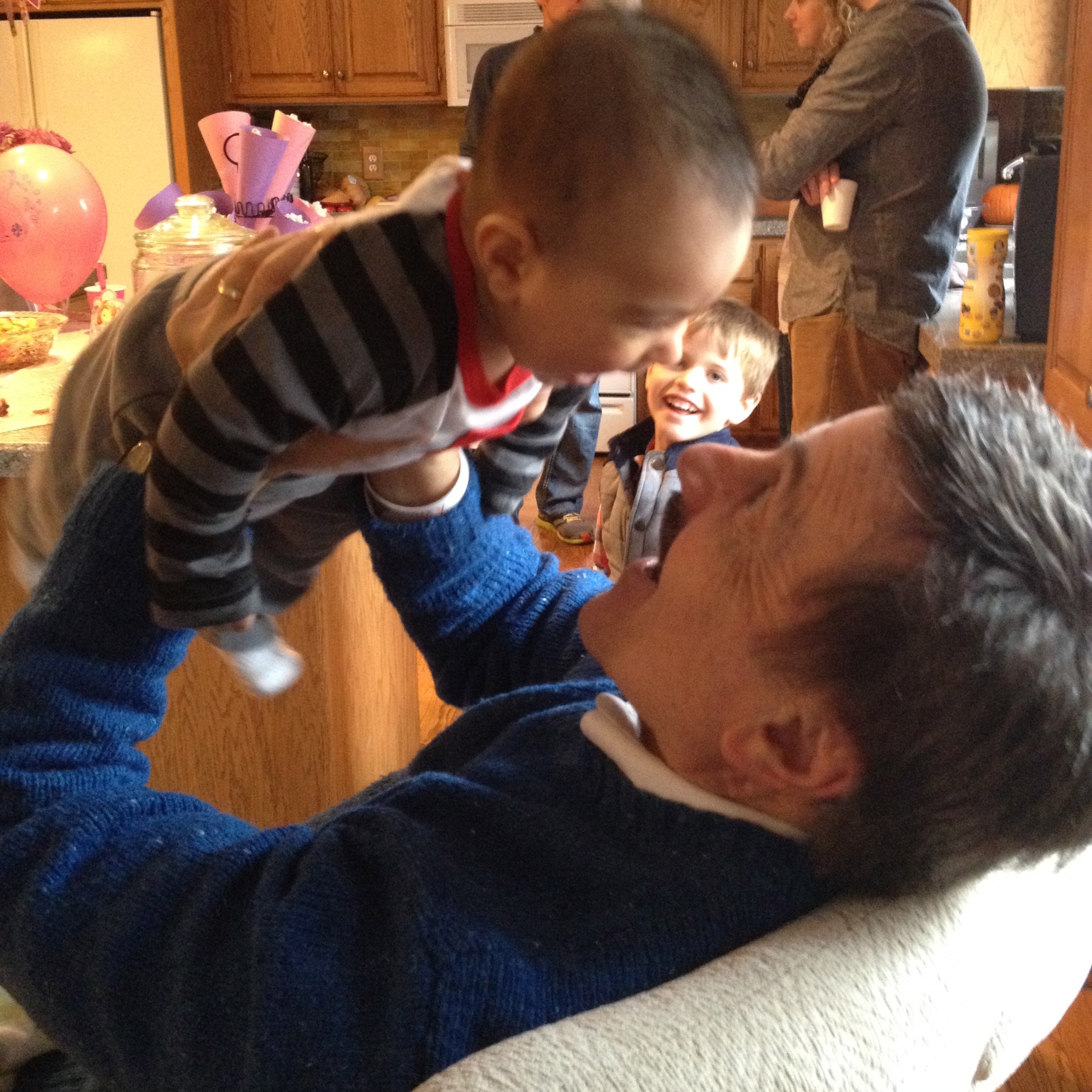
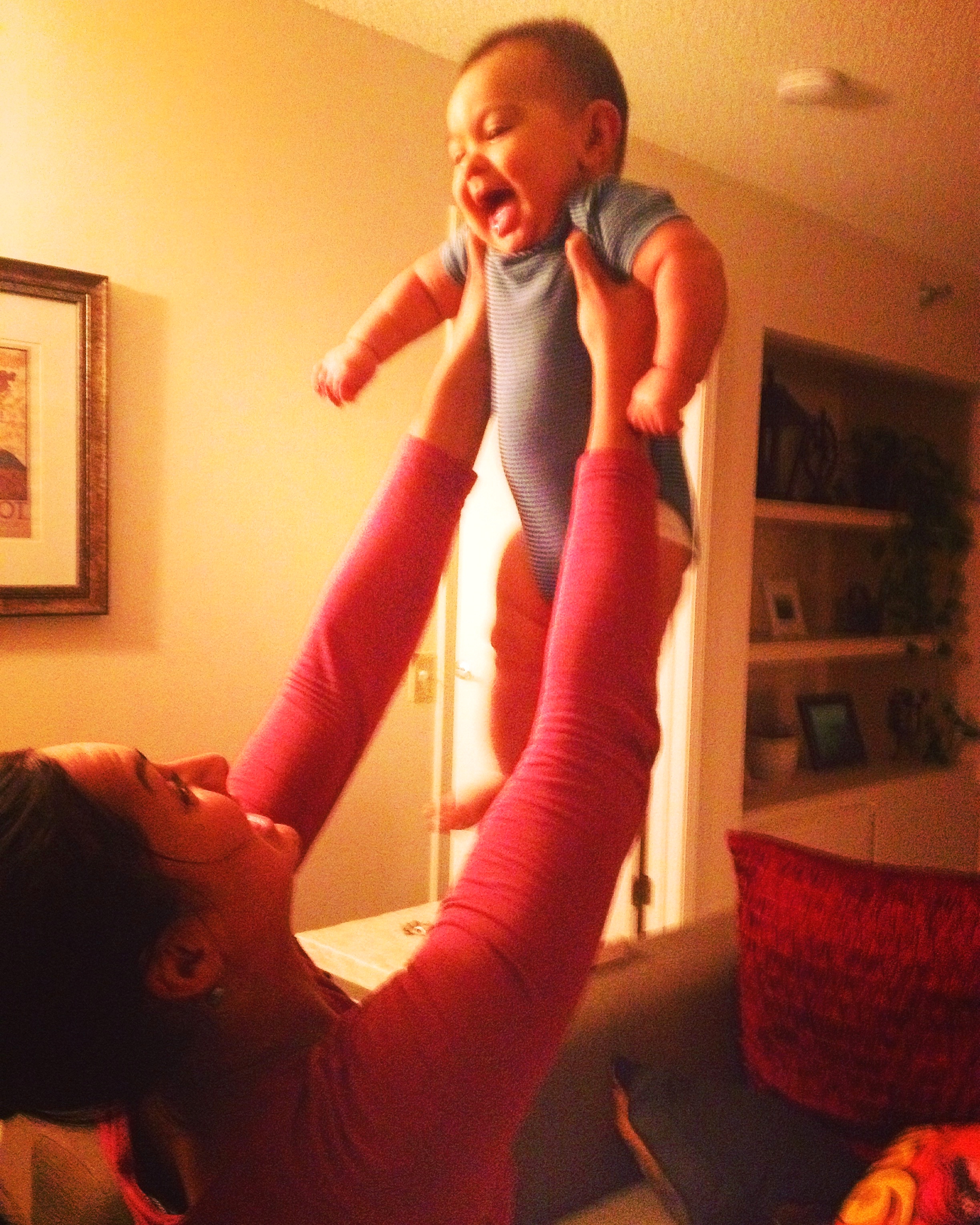
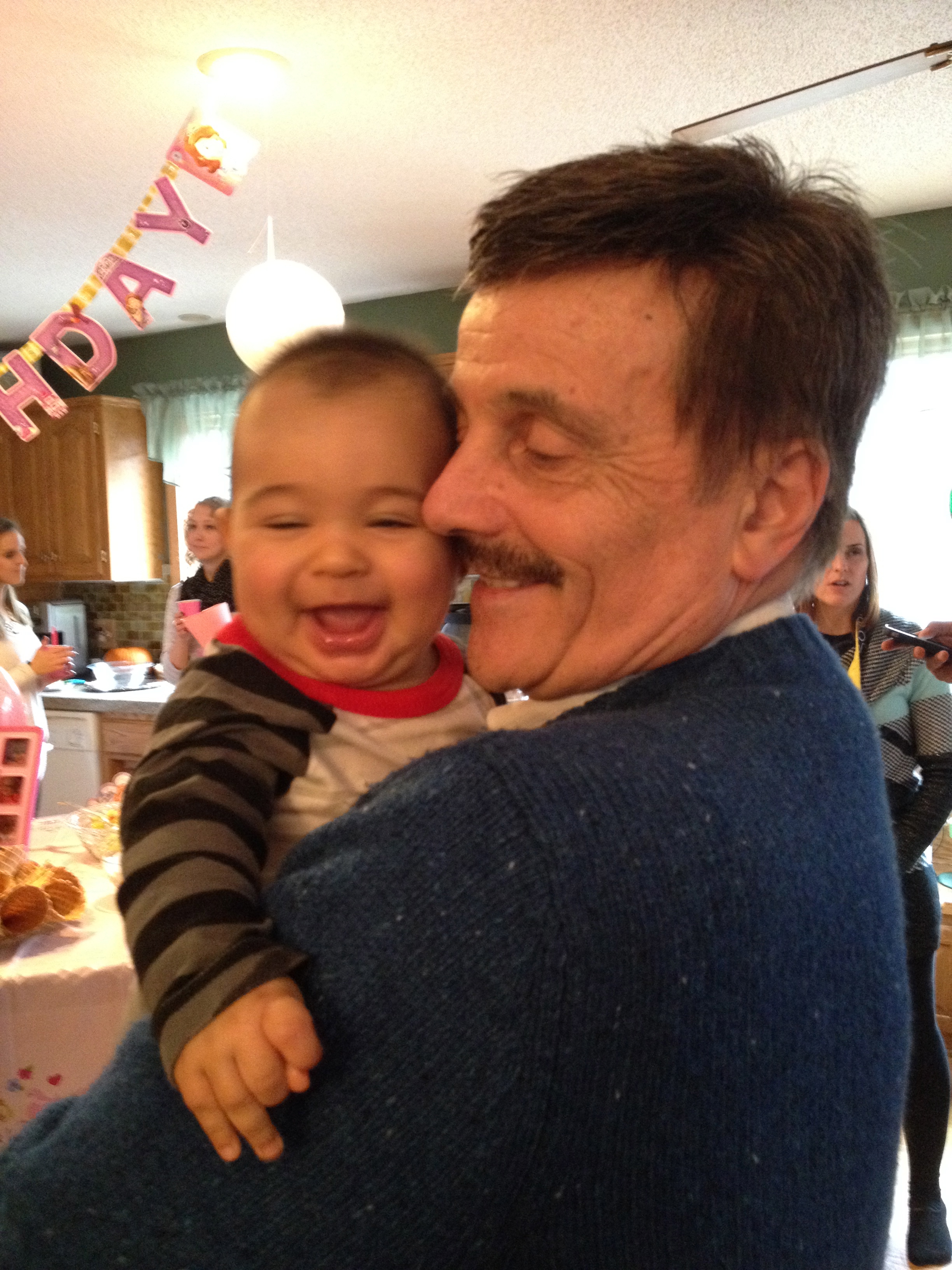
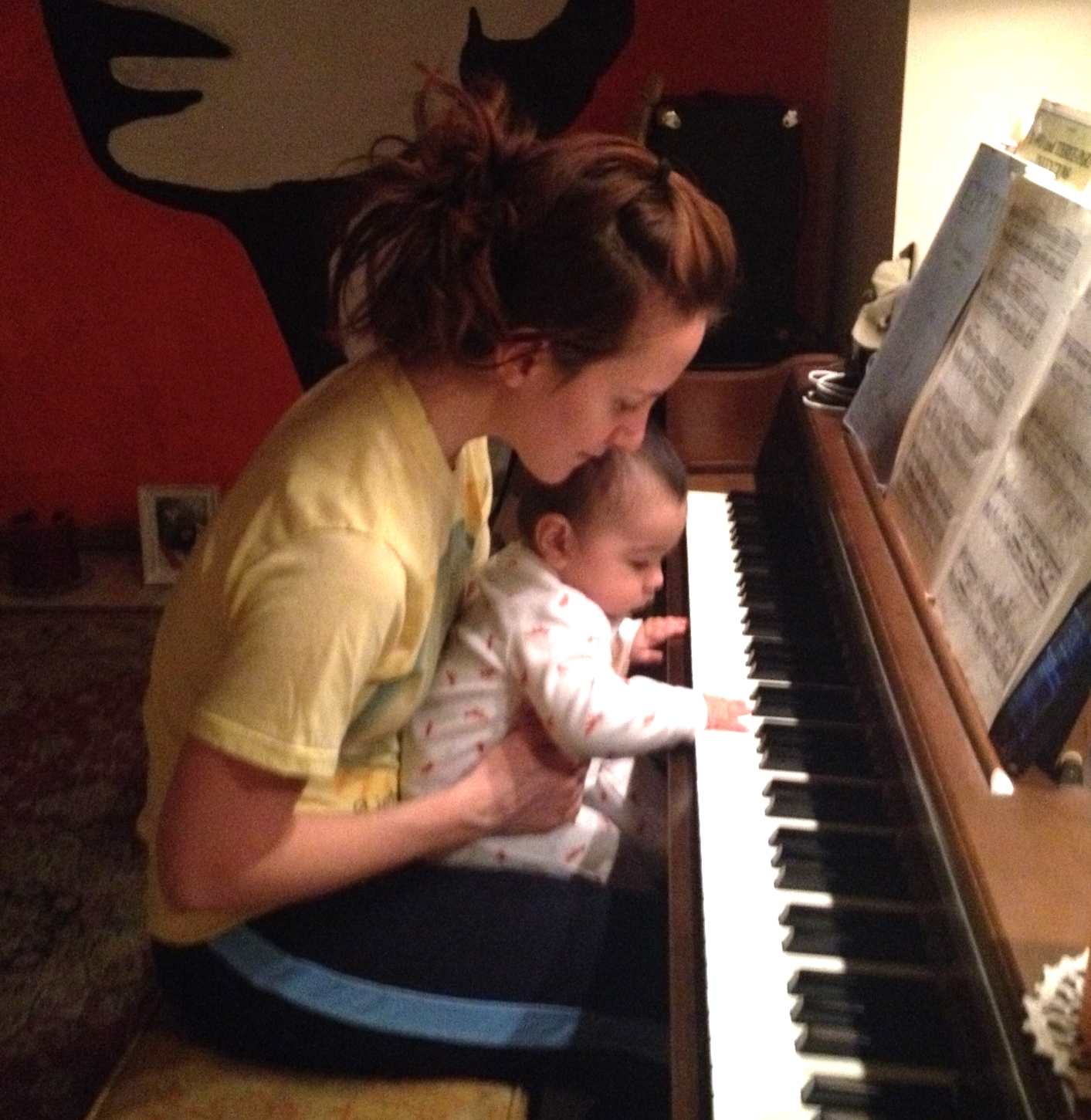

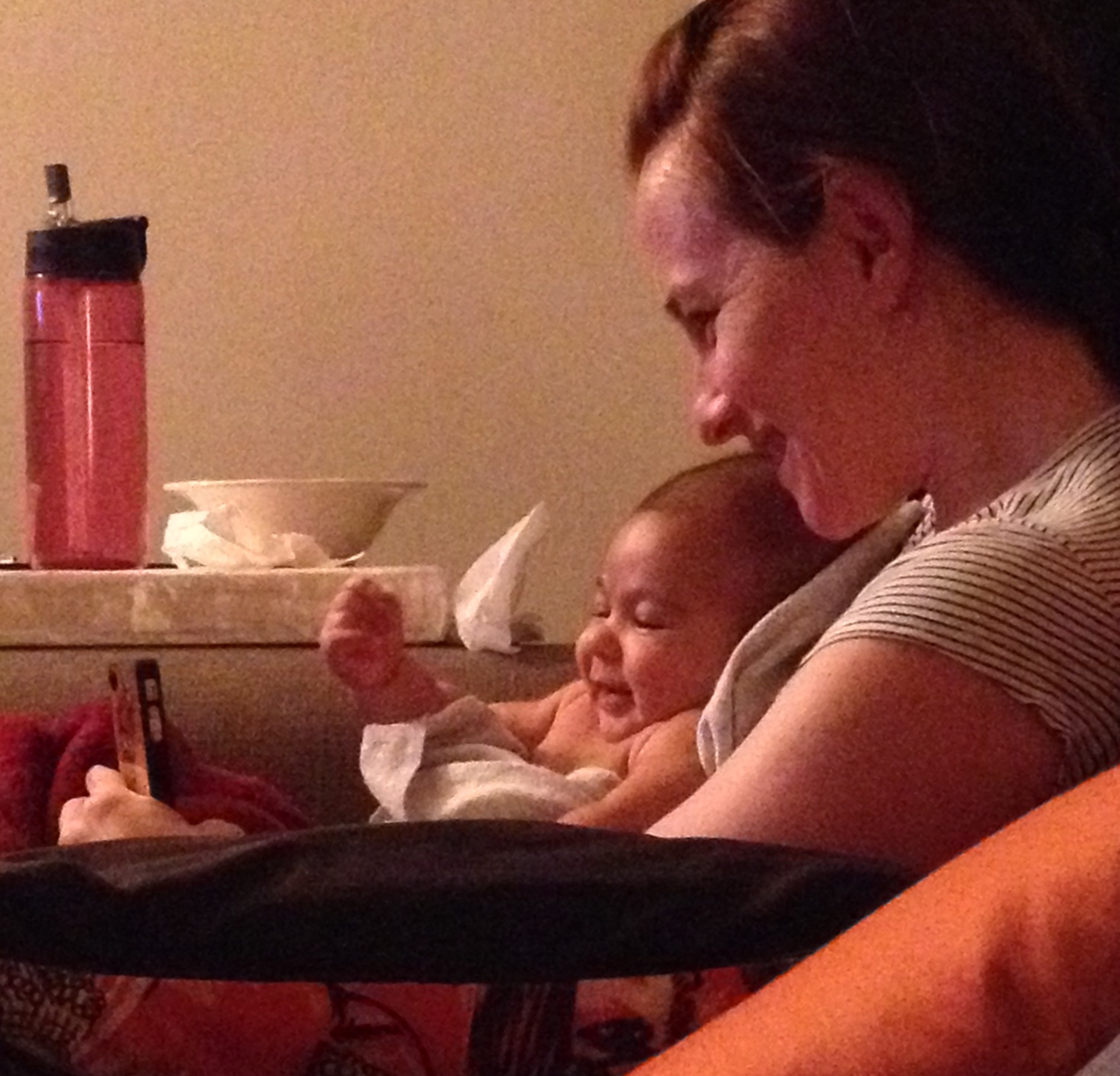
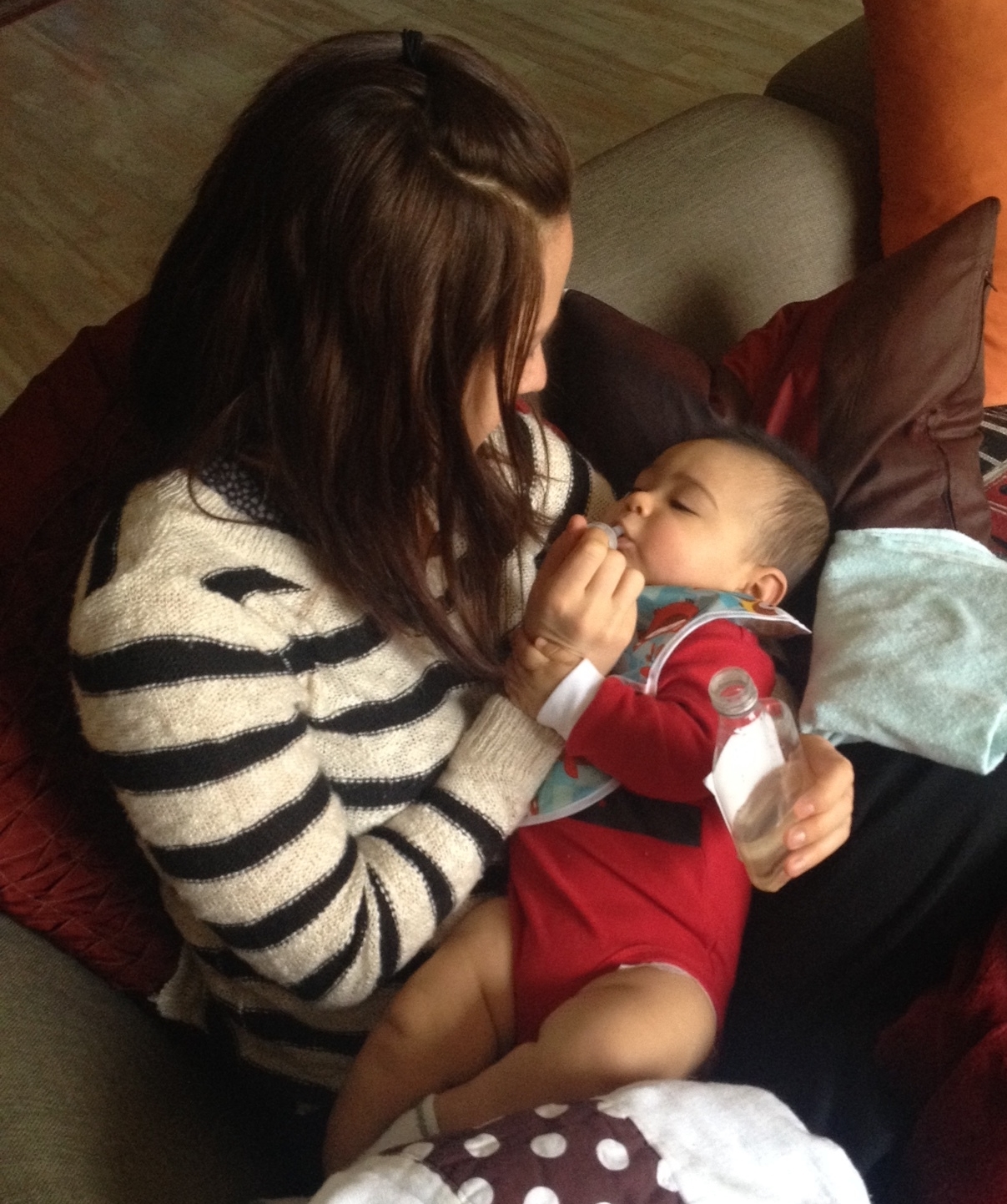
[photo credits Kelly and Sahil Merchant, Mia Divecha]
The physiologies of caregiver and baby harmonize in the process. In one study, Feldman observed the heart rates of mothers and babies as they played with each other face-to-face. When the interactions were synchronized in an easy back-and-forth, the rise and fall of mother and baby’s heartbeats actually tracked each other, with a one-second lag. In other words, the mother—or any sensitive caregiver—helps to regulate a baby’s very heartbeat through loving, synchronous interactions. Feldman postulated that this is likely internalized by the baby as an “emotional sense of security that accompanies the child throughout life.” Other studies show that oxytocin levels, and even brain alpha waves, track between mother and baby in synchronous interactions as well.
Quick timing is also essential for soothing a distressed baby. In a now-classic study on crying, researchers Sylvia Bell and Mary Ainsworth at Johns Hopkins found that babies whose caregivers consistently responded quickly to their cries, cried less often and for shorter periods of time by the end of their first year.
Some parents need help synchronizing.
Many new parents intuit their babies’ needs—and/or learn to identify needs through observation—but others can benefit from some explicit coaching. Jenny Goyne is a postpartum doula who helps new parents through the stresses of the postpartum period and is especially dedicated to helping parents identify and work with their baby’s rhythms.
“I often encourage parents to just observe and watch their babies,” she says. For example, when the baby is quiet and content, she points out to the parent just how the baby is taking in her people and the world around her, and Goyne encourages parents to give the baby space to do just that. “Many parents feel they need to ‘do something,’” she says, “like sing a song, or entertain the baby, or exercise or stimulate them. There’s a lot of entertaining going on.”
“I remind them—this is all new to a baby. They’re just becoming aware of what’s around them and trying to make sense of all of it all. Babies, especially in the early weeks, also tire easily, and parents may not realize that when the baby looks away, or yawns, or begins to fuss or even cry, that they’ve had enough.”
photo credit Nancy Kohli Haté
Even breastfeeding can require some patience and self-restraint at first. It can take some time for the baby to find her way into it. In some cases, new mothers feel like they have to do something to make breastfeeding happen, which tends to stress the baby, and then the baby picks up on the stress and doesn’t want to eat. Many older mothers who are professionals and used to having answers just want to know what to do to make it work. “I often simply help them relax,” Goyne says. In other cases, mothers and babies benefit from coaching: some babies need coaxing to latch on, and there are strategies for making breastfeeding more comfortable for both mother and baby. In some circumstances, breastfeeding is not even possible, so helping a mother come to terms with this may be important. “Conversations about what this means to a mother are important. There’s often a grieving process that needs to take place,” Goyne adds.
She also teaches parents to read the smaller nuances they might otherwise miss.
“Most people can tell the difference between smiling, crying, and sleeping, but we’re not so good at the subtleties of what babies are doing,” she says. For example, she points parents to the signs that a baby is about to transition between states, like the agitated movements or jerky motions or even hiccupping that can precede crying. Or the looking away that says she’s had enough. Anticipating babies’ needs can help keep their nervous systems organized for longer periods of time.
And then: Every baby is different.
“Babies don’t go by a book,” Goyne quips. “They have different temperaments. Some babies’ eyes are wide open. They’re taking in the world and are eager to interact. Others may be shy, or even a bit withdrawn. These babies need more space and perhaps less contact. The shy ones, especially, can make new parents feel insecure, sometimes causing them to work hard to get their baby’s attention, which can be quite overwhelming to a baby.”
“New parents might not realize that babies often enjoy having some time to themselves, to observe and experience the world without the parental filter,” says Goyne.
It doesn’t help that each practitioner tells a new parent something different. “The advice is not standardized,” she says. “You have to figure out on your own what works for your particular baby.” She supports parents in doing that by observing the baby and describing to the parent what she sees in terms of behavior and temperament, so that parents understand their own baby’s unique cues.
Some parents want to put the baby on a schedule to hasten the transition to “adult time,” but Goyne discourages that: “Babies don’t go by our clocks,” she says. “Many parents don’t realize that and think something’s wrong. They don’t know how to make sense of ‘baby time.’” Jenny’s job is done when parents gain confidence reading their baby’s signals—a few weeks for some, and up to three months for families with twins.
By three months, patterns of reciprocal interaction are well-established. By this time the baby starts to become skilled, herself, at initiating and sustaining interactions. She offers a social smile that makes the mom happy and the mom talks to her in return; the baby looks at an object in the distance and the father points and names the object; with a little encouragement from the baby, the grandpa excites her to screeching with silly play but quiets down when the baby crosses the threshold to being disorganized or upset. The adult is the baby's outsourced regulatory system.
Just how important this social connection is to a baby is demonstrated through the still-face experiment. Baby and mother face each other, cooing, talking, and touching, until the mother makes her own face stone-still and expressionless. The baby tries heroically to reengage the mother, even yelling and reaching for her, and when the efforts are futile, she falls apart in distress, sensing the connection is completely ruptured. When the mother reengages, though, the baby’s nervous system becomes calm, she smiles and re-engages, and the connection is restored.
The Goldilocks effect: Not too much, not too little, but good enough is best.
A cautionary note is in order for the overly-conscientious parent: Good enough is best. Within a normal range of interactions, babies, especially older ones, benefit from some variations in timings and styles. Babies get the gestalt of it. In normal human dialogue, mismatches and repairs are common. Infants get sensitized early to rhythm of these miscoordinations and interactive repairs, says psychologist Ruth Feldman at Bar-Ilan and Yale Universities.
Different adults have different kinds of rhythms, especially with older babies. For example, in research, fathers and mothers showed different kinds of interactive styles and different modes of co-regulation. With their five-month-olds, mothers typically played face-to-face and coordinated tiny, little interactions at a low-to-medium level of emotional arousal. They looked at things together, pointed, verbalized, and used gentle, affectionate touch. Fathers, on the other hand, were more exuberant: They laughed together and played physical games or games using objects. Their play was bigger, more open, and more exciting. They were just as synchronous, though, calibrating the back-and-forth between themselves and their babies; they were simply more emotionally intense and had different content. And mothers tended to be more synchronous with their daughters, and fathers with their sons, rather than the other way around. It's likely, though, that these kinds of patterns are not fixed but are flexible. The point is that babies can do fine with different styles of interacting.
It’s when the overall pattern is off that there is need for concern. Jenny Goyne described intrusive, anxious parents who feel the need to entertain a baby even when the baby is quiet and content. One study showed that these kinds of parents have higher activation in the amygdala, or fear regions of the brain in contrast to parents who are in synchrony with their infants and the reward regions (the nucleus accumbens) of the brain are activated. Psychiatrist Margaret Mahler has video footage of intrusive mother-infant pairs where the mother ignores the baby's signals that she wants to crawl or play her own way. When seen a year later, that baby is wrapped around the mother’s legs in anxiety, uninterested in exploring her world. Anxious mothers tend to miss the signals that their babies need space. In the process, they not only stress their babies; they also deprive them of the ripe opportunity to be content on their own, or to explore the environment on their own terms.
On the other end of the spectrum, when mothers are aloof or depressed, they hardly engage at all in the normal back-and-forth that settles a baby’s nervous system. Maternal depression is predictive of some of the worst outcomes for babies.
Important for future development.
Synchrony between caregivers and babies has lasting beneficial effects into toddlerhood and well beyond into adolescence, in almost every area that matters:
Emotion regulation, self-control, stress management: Feldman and her colleagues found that babies whose mother could follow their lead in infancy (3 months and again at 9 months), had better self-control at two years old than babies who did not have a synchronous relationship. This was especially true for babies with more difficult temperaments. Young children who’d experienced early synchrony were both more willing to pick up toys and put them away and more able to resist touching objects they wanted. Long-term studies show that early synchrony predicts lowered stress and better emotion regulation well into the teen years.
Social relationships: Babies who experience attunement with their caregivers become kindergartners who have more reciprocal, give-and-take relationships with their peers and they are better at resolving conflicts. As teenagers, they enjoy social relationships more and are more skilled at sustaining them.
Cognition: Two aspects of synchrony are particularly important to set the stage for optimal learning. One is the calm emotional state that is required for attention, learning and memory to happen. The second is the “serve-and-return” nature of the interaction, where babies learn cause-and-effect in their world, that the world is ordered, has governing laws, and is not chaotic. They become motivated only when they can make sense of the world and feel that they have some small bit of control and self-efficacy. Studies show that babies who experience synchronous relationships have higher IQs at two and four years old; their symbolic expressions—in language and play—are richer and more sophisticated; and their language refers more often to their own and others’ internal states, e.g., “I feel” and “You think.”
Attachment: Greater synchrony with caregiver in infancy is correlated with better attachment at one year, and fewer behavior problems at two years old.
Empathy: One study that followed babies from 3 months to 13 years old found that teenagers who had experienced synchrony with their caregivers as babies had greater empathy, suggesting that, as Feldman says, “synchrony sensitizes infants to the emotional resonance that underlies human relationships across the lifespan.”
You can’t spoil a baby.
photo credit Mia Divecha
New parents often wonder how soon their babies should become independent. The importance of the biological connection between sensitive caregivers and their babies should dispel those notions of independence. A baby cannot be spoiled, in fact the opposite is true. A baby needs a loving caregiver who gives her what she needs, on her terms, in order to wire up the major biological systems that create a foundation for later psychological and cognitive well-being. This synchrony is critical in the first month of life to organize and settle the nervous system, and it continues to remain very important in the sensitive period across the first year.
copyright Diana Divecha 2016
* * *
Additional Resources
What do doctors screen newborns for?
Developmental milestones in the first month
Tips for grandparents of newborns
How to find a postpartum doula
Books on physical care of newborns and infants:
Mayo Clinic’s Guide to Your Baby’s First Year
Your Baby & Child, by Penelope Leach
The Essential First Year by Penelope Leach
Caring for Your Baby and Young Child: Birth to Age 5, by the American Academy of Pediatrics
The Baby Book, by William Sears
The Wonder Weeks, by Frans Plooij and Hetty van de Rijt
